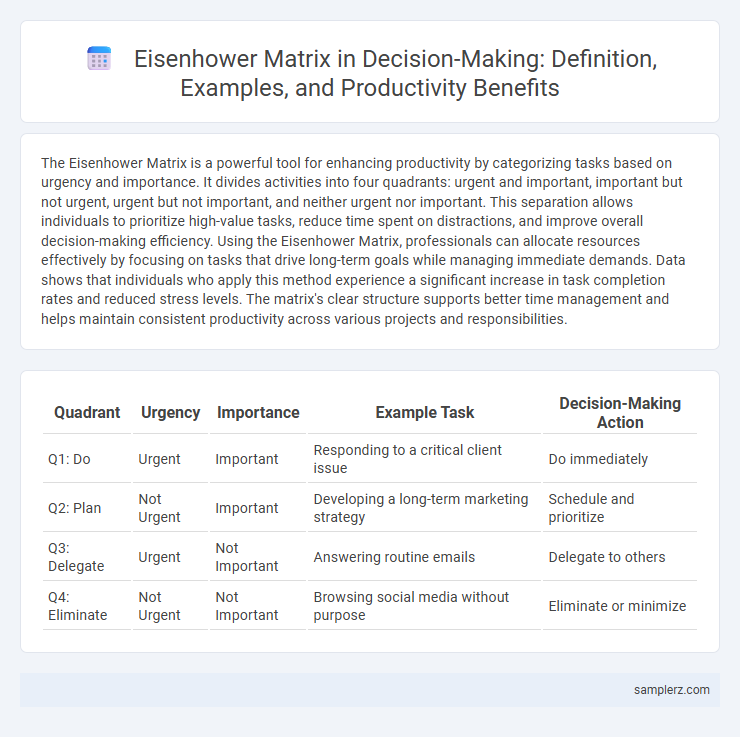The Eisenhower Matrix is a powerful tool for enhancing productivity by categorizing tasks based on urgency and importance. It divides activities into four quadrants: urgent and important, important but not urgent, urgent but not important, and neither urgent nor important. This separation allows individuals to prioritize high-value tasks, reduce time spent on distractions, and improve overall decision-making efficiency. Using the Eisenhower Matrix, professionals can allocate resources effectively by focusing on tasks that drive long-term goals while managing immediate demands. Data shows that individuals who apply this method experience a significant increase in task completion rates and reduced stress levels. The matrix's clear structure supports better time management and helps maintain consistent productivity across various projects and responsibilities.
Table of Comparison
| Quadrant | Urgency | Importance | Example Task | Decision-Making Action |
|---|---|---|---|---|
| Q1: Do | Urgent | Important | Responding to a critical client issue | Do immediately |
| Q2: Plan | Not Urgent | Important | Developing a long-term marketing strategy | Schedule and prioritize |
| Q3: Delegate | Urgent | Not Important | Answering routine emails | Delegate to others |
| Q4: Eliminate | Not Urgent | Not Important | Browsing social media without purpose | Eliminate or minimize |
Understanding the Eisenhower Matrix: A Quick Overview
The Eisenhower Matrix categorizes tasks into four quadrants based on urgency and importance, helping prioritize effectively. Tasks in Quadrant 1 are urgent and important, requiring immediate action, while Quadrant 2 focuses on important but non-urgent activities that drive long-term goals. Quadrants 3 and 4 include tasks that are either urgent but not important or neither urgent nor important, often candidates for delegation or elimination to optimize productivity.
Importance vs. Urgency: Core Principles Explained
The Eisenhower Matrix categorizes tasks into four quadrants based on importance and urgency, helping prioritize actions that maximize productivity. Tasks in the "Important and Urgent" quadrant demand immediate attention, while "Important but Not Urgent" tasks should be scheduled to prevent crises. This decision-making tool emphasizes focusing on high-impact activities to improve time management and reduce stress.
Real-Life Example: Applying the Matrix to Daily Work Decisions
The Eisenhower Matrix categorizes tasks into urgent-important, important-not urgent, urgent-not important, and neither to optimize productivity in daily work decisions. For example, a project deadline (urgent-important) is prioritized immediately, scheduling strategic planning (important-not urgent) for later, delegating routine emails (urgent-not important), and eliminating distractions like social media (neither). This method improves focus, reduces stress, and enhances effective time management in everyday work environments.
Eisenhower Matrix in Project Management Scenarios
The Eisenhower Matrix helps project managers prioritize tasks by categorizing activities into urgent-important, important-not urgent, urgent-not important, and neither urgent nor important quadrants. In project management scenarios, this method ensures critical deadlines are met while strategic planning and resource allocation receive adequate attention. Applying the Eisenhower Matrix improves decision-making efficiency, reduces task overload, and enhances project delivery outcomes.
Prioritizing Tasks: Sample Matrix for a Marketing Team
The Eisenhower Matrix categorizes tasks for a marketing team by urgency and importance, assigning campaign launches to "urgent and important," routine social media posts to "not urgent but important," minor updates to "urgent but not important," and administrative paperwork to "neither urgent nor important." This prioritization method improves focus on critical activities such as strategy development and client targeting, directly boosting overall productivity. Implementing the matrix reduces time spent on low-impact tasks, streamlining workflow and enhancing campaign effectiveness.
Personal Productivity: Eisenhower Matrix for Time Management
The Eisenhower Matrix categorizes tasks into four quadrants based on urgency and importance, helping individuals prioritize effectively for enhanced personal productivity. By focusing on important but not urgent tasks, such as long-term goal planning, users reduce stress and avoid last-minute crises. Implementing this decision-making tool ensures efficient time management and balanced workload distribution.
Delegation Decisions Using the Matrix: Practical Illustrations
Delegation decisions using the Eisenhower Matrix involve categorizing tasks into urgent but not important, which are ideal to delegate to team members. For instance, scheduling meetings or routine follow-ups qualify as urgent but not important tasks that free up leadership for strategic priorities. Employing this matrix enhances productivity by aligning delegation with task urgency and importance, ensuring efficient resource allocation.
Avoiding Procrastination: Matrix Examples for Students
The Eisenhower Matrix helps students prioritize tasks by categorizing them into urgent-important, important-not urgent, urgent-not important, and neither urgent nor important, effectively reducing procrastination. For example, homework due tomorrow falls into urgent-important, prompting immediate action, while long-term projects fit important-not urgent, encouraging consistent progress without last-minute stress. This decision-making framework enhances productivity by ensuring that critical academic tasks are addressed promptly and less important distractions are minimized.
Crisis Management: The Matrix During High-Pressure Situations
The Eisenhower Matrix enhances crisis management by categorizing tasks into urgent-important, enabling leaders to prioritize critical actions swiftly during high-pressure situations. By distinguishing between tasks that need immediate attention and those that can be delegated or deferred, decision-making becomes more efficient and strategic. This structured approach minimizes overwhelm, ensures resource allocation aligns with crisis severity, and drives timely resolution of emergencies.
Remote Work: Eisenhower Matrix in Virtual Collaboration
The Eisenhower Matrix optimizes remote work by categorizing virtual tasks into urgent-important, important-not urgent, urgent-not important, and neither, enhancing focus during virtual collaboration. Prioritizing urgent-important tasks like critical client meetings ensures timely responses, while delegating urgent-not important items such as routine emails improves team efficiency. Incorporating this matrix in remote work platforms streamlines decision-making and maximizes productivity across distributed teams.

example of Eisenhower-matrix in decision-making Infographic
 samplerz.com
samplerz.com